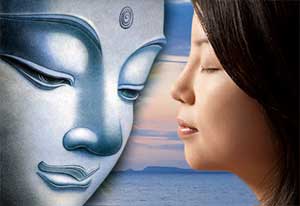By P Laxma Reddy, New Indian Express, August 23, 2014
VIJAYAWADA, India -- In an important excavation
executed by the Archaeology Department after finding a wall at
Bhimeswara temple at Chebrolu village in Guntur district, the officials
have unearthed six railing posts of the Buddhist Stupa and several other
precious remains.
 << Bhimeswara Temple where the excavation was carried out at Chebrolu in Guntur district | EXPRESS PHOTO
<< Bhimeswara Temple where the excavation was carried out at Chebrolu in Guntur district | EXPRESS PHOTOIt may be recalled that the a brick alignment (wall) was unearthed on August 12 while digging on the southern side of the Bhimeswara Temple premises as a part of the temple renovation works taken up by the Archaeology Department. Following this, a team of officials of the Archaeology Department including assistant director K Chitti Babu, deputy executive engineer Koteswaran and technical assistant B Deepak Joe visited the place on August 16 and decided to explore the site further, anticipating some valuable remains there.After the excavation, they have found the railing posts depicting Lotus Medallions and a row of animals. They also found a sculpture in which Bodhisattva is seen worshipped by a group of devotees, an image of a mystical animal and a ‘Yaksha’ on these posts.
“We have also found a sculpture in which the devotees are seen worshipping a Stupa by garlanding it, and large bricks (52 x 27 x 8cm size) at the site,” said Chitti Babu and added that an inscription of temple in Telugu-Kannada language has also been found.
“But this inscription belongs to medieval times when Telugu and Kannada languages had one script. A Buddhist pillar has been flattened to make this inscription,” he said.
Chebrolu was a territorial capital at that time. The remains found at the temple might belong to 1st or 2nd century AD, according to the officials.
When asked about taking up further excavation at the site, the officials said that they do not have any such plans right now.
Buddhism flourished during the Satavahana and Ikshvaku dynasties as they have patronised the religion. But the rise of Vishunkundinis (Vaishnavaites), Pallavas (Shaivites) and Eastern Gangas (Shaivites) has helped Hinduism revive itself and so Buddhism disappeared in these areas. The Buddhist sites have turned into Hindu temples.
Meanwhile, the Union government has sanctioned `1.48 crore grants from the 13th Finance Commission for the renovation of Bhimeswara temple, Adikeswara temple, Nageswara temple and Chaturmukha Brahma temple.
A Crucible of Buddhism
Chebrolu is an ancient village located about 17 km from Guntur. It is situated on a large mound, the excavation of which revealed several terracotta figures and Roman coins. Its ancient name was Sambhole (from which ‘Chebrolu’ is derived).
The Brahmalingeswara Chaturmuka Brahma temple has a small shrine situated in the middle of the temple tank. The main deity is a Siva Lingam, which has four images of ‘Brahma’ carved on its sides.
As many as six Stupa posts have been unearthed at the site.
The officials say that they may not take up further excavation at the site.
Remnants of a Buddhist monastery, dating back to pre-Satavahana period, unearthed atop the Bhairavakonda hillock at Vaikuntapuram village in Thullur mandal of Guntur district in March, 2013.
Another Buddhist site, belonging to the 2nd Century AD, unearthed near Pondugula village in March 2013.

 Outpouring
of people from all walks of life from all parts of the country dressed
in formal suits and ties displayed a rare occasion of Sri Lankans from
all communities, Sinhala, Tamil, Muslim and their British friends and
well-wishers eagerly waiting to hear a distinguished panel of speakers
chaired by the Lord Sheikh the president of the Conservative Muslim
Forum and organised by his staff.
Outpouring
of people from all walks of life from all parts of the country dressed
in formal suits and ties displayed a rare occasion of Sri Lankans from
all communities, Sinhala, Tamil, Muslim and their British friends and
well-wishers eagerly waiting to hear a distinguished panel of speakers
chaired by the Lord Sheikh the president of the Conservative Muslim
Forum and organised by his staff. There
has also been questions raised over the vulnerability of some of those
who seek meditation as a form of treatment, regarding the increase in
awareness and the emotions this can conjure.
There
has also been questions raised over the vulnerability of some of those
who seek meditation as a form of treatment, regarding the increase in
awareness and the emotions this can conjure. In
a recent interview with a German newspaper, Welt am Sonntag, the Dalai
Lama underscored his belief that the tradition of the post he holds
could end with him. He said Tibetan Buddhism was not dependent on a
single person.
In
a recent interview with a German newspaper, Welt am Sonntag, the Dalai
Lama underscored his belief that the tradition of the post he holds
could end with him. He said Tibetan Buddhism was not dependent on a
single person.




